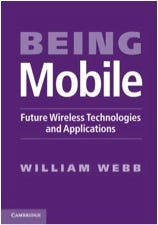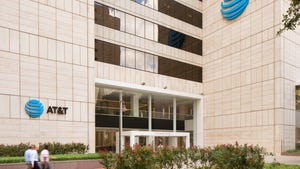Location is where it’s at
In the third instalment from the serialisation of his book Being Mobile on Telecoms.com, Ofcom’s William Webb looks at the potential for the evolution of location services, and what needs to be done to make it happen.
November 17, 2010

By William Webb
In the third instalment from the serialisation of his book Being Mobile on Telecoms.com, Ofcom’s William Webb looks at the potential for the evolution of location services, and what needs to be done to make it happen.
Broadly speaking, location is about knowing where someone or something is. It may be about knowing where you are in order to navigate to somewhere else or find something, for example. Or it may be about knowing where other people are for all sorts of reasons.
At different times different types of location information are useful. When using an in-vehicle satnav, the precise position of the car in terms of its geographical coordinates is crucial. In another situation it may be sufficient simply to know whether a person is at home or not.
Sometimes location is relative, such as wanting to know how far away the nearest restaurant is. Sometimes it is helpful to also know which way a person is orientated, for example in order to provide them with information on the building that they are looking at. Sometimes precision is important, in other situations a location accurate to within a kilometre or two may be adequate. Hence, understanding location is not just as simple as assuming that, once a GPS fix has been made, the problem is solved.
While GPS is the most common method of location, there are many different ways of locating devices. One alternative is to make use of network identity information. A number of systems listen for the identity codes of nearby wifi base stations and report these back to a network-based database which has been pre-populated with the location of known wifi base stations based on earlier surveys. Because wifi hot-spots only cover a few hundreds of metres this is reasonably accurate, although there may not be any hot spots within range or the name of local hotspots may have changed. It is also possible to listen to the identity of cellular base stations or broadcast towers, although since these tend to have larger cells the accuracy falls as a result, perhaps to 1km or worse.
Device-based approach
A different approach is for the network to determine where a device is. In this case, rather than the device listening for signals from multiple transmitters (eg satellites), multiple receivers in the network (eg base stations) listen for the signal transmitted from devices. There has been much work on this in order to determine the location of cellular phones, especially when making an emergency call, but it is not widely used because of its cost.
As the Apple App Store has shown, many different applications based on location can be envisaged—from “find the nearest Starbucks” to “show me which of my friends are close by”. Many more applications of location are likely to emerge over time. One of the most obviously useful is the ‘whereabouts clock’.
In the Harry Potter novels, there is a device in the home of the Weasleys that looks rather like a grandfather clock, with one hand for each member of the family. Around the face of the clock are locations such as “work”, “home”, “pub” and “travelling”. The hands move around the clock as family members travel, showing at a glance where the family is located. Location is not represented as a person’s actual coordinates but by which of a number of possible location categories they fall into. The clock is always up to date—as with an ordinary clock there is no need to press a “refresh” button to update it. In the Harry Potter novels this clock works by magic but it would be simple to implement it using available technology.
The outline of such a clock would be a device in the home (perhaps the kitchen) which might be based on a tablet PC, with an always-on screen, running the location application. It would have wireless capabilities to connect to various networks and family members would be located using the wireless devices that they were carrying.
There are two approaches that could be adopted to determining the location of family members – device based or network based.
In a device based approach, the personal device of each family member would work out its location and send information to the network or directly to the home monitor. The device might continuously check its location using GPS or it might periodically check based on whether it had been moved (using its internal accelerometer). It might also want to monitor WiFi identities as this might be a good guide as to when it was in particular named locations such as the home. The home monitor would then interpret this information and display it accordingly.
This approach is relatively simple to implement, requiring only an appropriate application for the device, but would require the device to have GPS and WiFi capabilities and to leave these running for much of the time. The device would also be frequently sending location messages which may drain the battery and incur network charges. The Google Latitude application works somewhat in this manner, displaying the location of a preset list of people whenever the application is invoked on a computer screen and could be argued to already be close to the whereabouts clock. However, it only works on a relatively small subset of handsets and does not continuously update or categorise location into a short list of possibilities.
In the network based approach, the cellular network determines the device location based on an understanding of the cell, or sets of cells (known as location areas), that the device is in. This information is generated automatically as the device moves around the network, primarily so the device can be located if there is an incoming call, but can also be used to provide approximate information. Coupled with wifi identification of specific locations this may provide sufficiently accuracy.
The advantage of this is that it works with all handsets and does not cause any additional battery drain. The operator can deduce that a handset has moved when its location area changes and send this information to the home monitor, perhaps directly using a cellular link.
The downside is that it will require minor modifications in the network location registers in the cellular networks. It may also be problematic if different members of the household are using different cellular network operators since they may not all implement the solution, or may not do so in a compatible manner. Although some operators have made an effort to provide family location, in general this is not available.

BeingMobile
With all location applications there are some ethical issues around tracking of individuals. But it is conceivable that, in a family where consent is provided by all, these issues would not be major problems.So both device-based and network-based solutions for a real-world ‘whereabouts clock’ could readily be implemented today, although each has its shortcomings. The application seems as if it would be very valuable to users but, as yet, no solutions are widely available. This is largely due to the current structure of the industry and the desire of mobile operators to keep location data to themselves.
Augmented reality
Existing location services are mostly based on determining where the user is, where other users are and, if required, providing means of getting from one to the other. They essentially provide a better map. Some proposed location services move beyond this and into the world of virtual reality.
The departure point for a range of new services is a form of augmented view. Here the user holds their mobile device like a camera, pointing towards a view or object that interests them. Using GPS the mobile device works out where it is and, using an embedded compass (a necessary feature for this service), it works out the direction in which it is being pointed.
A camera in the front of the phone relays the image of what the user is looking at onto the phone screen so the phone screen appears to the user to be a window through which they are looking onto the view. Additional information, such as the names and heights of mountains, the review ratings of restaurants in view and so on, can then be overlaid by the phone. This information is retrieved from databases which know the location of each point of interest and can deduce where that will fall within the view of the user. Current examples include a real estate application showing information about homes for sale superimposed on the video feed and a service that displays mountains with peaks identified.
An enormous number of possible applications for this augmented view are imaginable; from showing a recommended route superimposed on the real world to tourist information for visitors walking around a town. It’s important to remember that augmented view does not have to depend on location. An augmented view of products in a shop could be provided if there were some barcode or RFID on each item that the phone could recognise and use to look up an appropriate database, such as review comments about books on a shelf.
Where location is required, however augmented view only needs devices to have GPS, a compass and be able to download the appropriate application. The views available then depend on the information provided by entities such as Google Maps and many other bodies. Given the relatively rapid speed with which users replace mobile devices it seems likely that augmented view will be adopted over the coming few years. Network requirements are relatively limited—the phone transmits only its location and direction of pointing to the network and the appropriate website returns a small amount of information for the phone to process.
Once the phone is able to add to, or modify “reality” then it is a short step to virtual reality. The phone could make the world appear a better place by modifying the sky. It could replace modern day buildings or cars with those from yesteryear. It could add other virtual people into the picture or could even create an entire virtual world where the user could experience the views they would see from some other viewpoint. The phone could become incorporated into glasses that added a “heads-up display”, superimposing additional information on reality.
Applications that presented user with the name and last time of meeting anyone walking towards them could be provided based on face recognition or information sent from other users’ mobiles. Whether any of this is actually valuable or acceptable is not clear, but location makes it technically possible and existing wireless networks provide sufficient capacity and coverage.
An abridged extract from “Being Mobile” by William Webb, Cambridge University Press 2010
You May Also Like









_1.jpg?width=300&auto=webp&quality=80&disable=upscale)


.png?width=800&auto=webp&quality=80&disable=upscale)